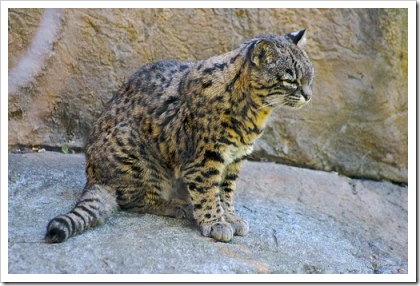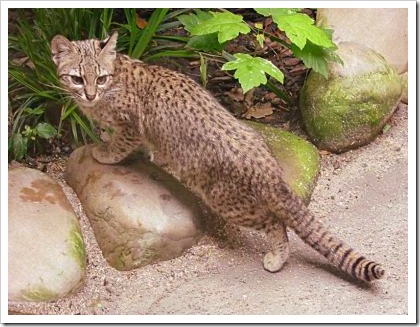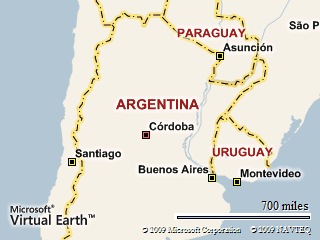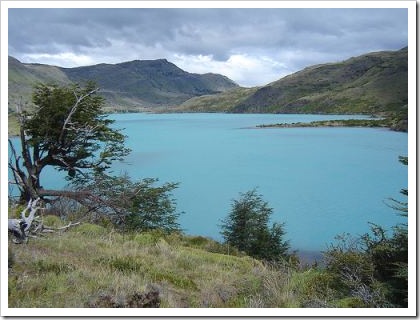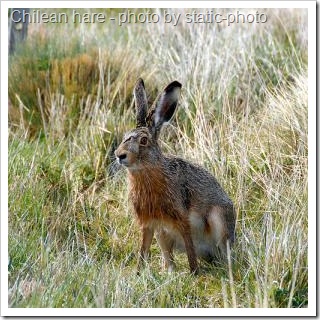The name Geoffroy’s Cat is unusual as it is named after French naturalist, Étienne Geoffroy Saint-Hilaire, “who identified Geoffroy’s Cat as a different species” (src: Wikipedia) whilst a professor of zoology when in Paris, France. The middle name is a Germanic version of the more familiar Geoffrey. This, I am sure causes problems when searching for information! The scientific name is easier: Leopardus geoffroyi.
OK, down to work. Here is a picture by a Flickr photographer of the Geoffroy’s cat:
Geoffroy’s Cat by treviño![]() . Published under a creative commons license and taken at Sacramento Zoo, California.
. Published under a creative commons license and taken at Sacramento Zoo, California.
This cat has a striking tabby![]() spotted coat, which has been its undoing. It has been widely hunted in its native habitat (Brazil, Chile, Argentina, Bolivia, Paraguay, Uruguay) and the pelts (I prefer the word “skin” and fur as it does not disguise what it actually is) exported via the international fur trade, over the period 1960 to 1980s (see Cat Fur – Switzerland
spotted coat, which has been its undoing. It has been widely hunted in its native habitat (Brazil, Chile, Argentina, Bolivia, Paraguay, Uruguay) and the pelts (I prefer the word “skin” and fur as it does not disguise what it actually is) exported via the international fur trade, over the period 1960 to 1980s (see Cat Fur – Switzerland![]() fur trade now banned in the EEC).
fur trade now banned in the EEC).
This wild cat species weighs between 4 to 9 lbs (2-4 kgs) to a maximum of about 18 lbs, which is similar to an average domestic cat (see Largest Domestic Cat Breed) although 18 lbs is at the top end of the domestic cat range (Maine Coons and Savannahs). It is considered “a small solitary felid (4.3 kg)” by IUCN Red List for Threatened Species™.
It has been crossed with a domestic cat to produce the wild cat hybrid, the Safari Cat, a relatively little-known wild cat hybrid that is a domestic cat. However, there are difficulties in creating this wildcat hybrid.
Geoffroy’s Cat from Wikimedia Commons file and reproduced under license. Author: Daf-de. Taken at Zoo Karlsruhe, Germany.
IUCN Assessment
This species is considered Near Threatened, which means:
“…..a conservation status assigned to species or lower taxa that may be considered threatened with extinction in the near future, although it does not currently qualify for the threatened status. As such the IUCN notes the importance of re-evaluating Near Threatened taxa often or at appropriate intervals.” (src: Wikipedia reproduced verbatim under license).
The future threat as described by the IUCN Red List for Threatened Species™ (Red List) is that it might, in the future, be reclassified because of a threat to survival from “habitat conversion”. This must refer to habitat loss for commercial reasons such as logging and farming. The population, unsurprisingly, is decreasing.
Update Dec 2017. Now classified as LEAST CONCERN. This indicates an improvement in the survivability of the species in the wild. I am surprised to see this.
Range Habitat & Ecology
The range of this cat species:
- South-eastern Bolivia
- Paraguay
- Argentina east of the Andes
- Southern Brazil (below ca. 30oS)
- Uruguay (to the Strait of Magellan in Chile)
And it is found in the above areas from sea level to 3,300 meters above sea level.
This map opens in a new window ![]()
Update: I have prepared a map on this cat’s distribution. Here is a small version of it:
View Geoffroy’s cat range in a larger map
See this custom map in large format plus more on this page: Geoffroy’s Cat Range
Within these counties there are a wide range of habitats from subtropical to temperate, where this cat is found, namely:
- scrubby woodland
- dry forests, shrub, woodlands & savannahs (Chaco)
- scrub (Patagonia)
- desert (Monte)
- alpine saline desert (NW Argentina)
- woods and grassland (Pampas)
- Andes mountains up to 3,300 meters
Chile – Torres del Paine a habitat for Geoffroy’s Cat. Photo by vtveen![]() published under a Attribution-NonCommercial-NoDerivs creative commons License .
published under a Attribution-NonCommercial-NoDerivs creative commons License .
It favours denser cover and arid to semi-arid landscape but is sometimes found in wetlands. As to the size of this cat’s home range:
- mean home range from 2.5 to 3.4 km².
- Sometimes the range is larger as in the Torres del Paine National Park (see above), in beech forest (Chile) where it is “2.3-6.5 km² for two females, and 10-9-12.4 km² for two males” (src: Red List).
As to diet, this is varied and depends on location:
- small rodents and birds (Argentina)
- rodents and hares (Chile – see photo below)
- introduced brown hairs (southern South America)
- fish and frogs (Brazil and Uruguay)
- small mammals (Lihue Calel)
Photo published under a Attribution-NonCommercial-NoDerivs creative commons License — this site is for charitable purposes in funding cat rescue. By static-photo![]() .
.
Threats and Conservation
Threats to survival in the wild can be summarized as:
- fur trade despite hunting and trade being banned in Brazil, Chile, Argentina, Bolivia, Paraguay and Uruguay
- killed by farmers to protect livestock
- habitat loss
- habitat fragmentation resulting in breeding problems
- the contracting of life threatening diseases found in domestic cats (see Cat Health Problems)
- other threats not yet quantified
Protection for Geoffroy’s Cat also comes from reserves and it is listed in CITES Appendix I – definition:
[Appendix I] lists species that are the most endangered among CITES-listed animals and plants….They are threatened with extinction and CITES prohibits international trade in specimens of these species except when the purpose of the import is not commercial….(src: CITES, quoted verbatim for accuracy)
![]()
From Geoffroy’s Cat to Wild Cat Species
Sources/Reference: Red List, Wikipedia, PoC

